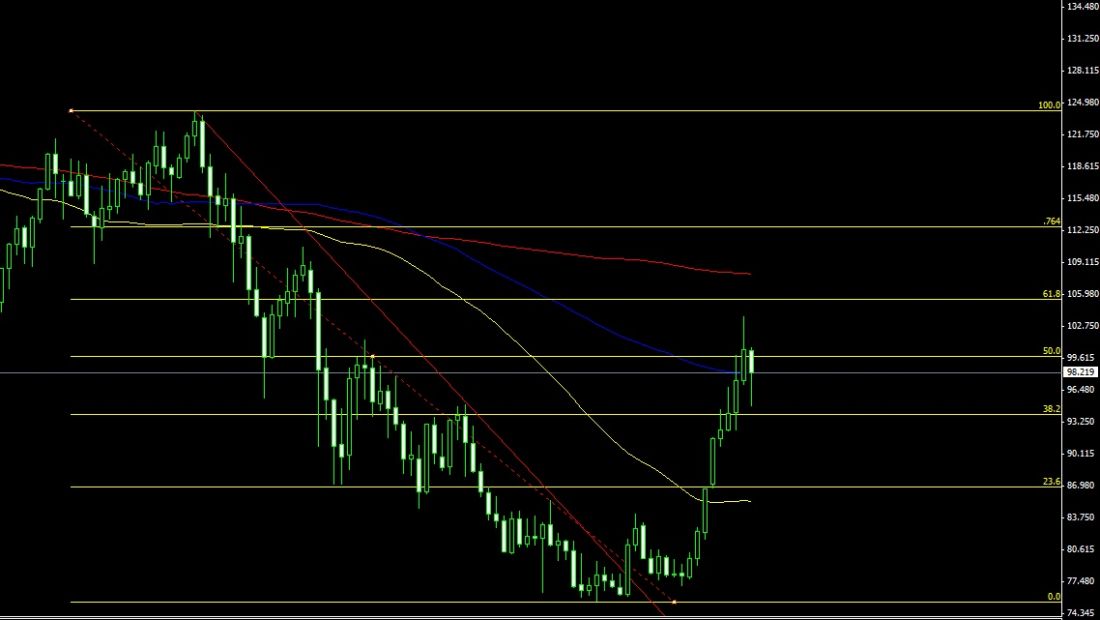The average economist has predicted 12 of the last four recessions. –unknown
A few weeks ago, I said entry is important, but if you’re going with the trend just getting into the market is more important than picking an entry. Again, you can make money counter trend trading and catch pips in a consolidative movement. It’s even fun to “pick tops” and when I’m scalping the market I will do this for a few pips if the circumstances are right. But the real money is made in finding a trending market and sticking with it.
Let’s look at the dollar/yen (USD/JPY) for a minute. Below is a monthly chart. The dollar bottomed in November of 2011. Now, of course we didn’t know that at the time, but we had indications that things would turn around. The red trendline I stuck on there had been respected since 2007. I don’t care if you think technical trading is a bunch of bunk.
Breaking a line that had held for five years is pretty intense. Since that bottom, we’ve seen the dollar appreciate by right around 25 cents. That’s two thousand, five hundred pips (give or take). And the reason I pick this as a bit of an extreme example is because there were very few substantial pullbacks in that dynamic long move.

The person who insists on picking the top would probably short on the 100 day, week and month moving average. At some point, you’re just being stubborn. Then again, at some point you’re probably going to stumble onto being right. The yellow moving average is the 50 month moving average. This is within a few pips of the 200 week moving average, and it doesn’t take a brilliant technical guy to know a lot of people use this as one of the last indicators of a trend change.
Well, this level offered no significant resistance.
Likewise, some people (myself included) like to short a long move off of prior support / resistance levels. How about the .236, .382 .50 or .618 monthly fib retracement I’ve illustrated? Or the blue 100 month moving average line? None of those really did a lot to our Yen graph here. Now, looking at a daily or four hour chart, there were some possible short moves for a few pips here and there.
But those are hard to catch. For the last eight months there were maybe a handful of days where the astute trader could have made some money trading short. But, the largest pullback (not counting last week) was a few hundred pips.
Of course that’s a pretty big stop, and I’m not suggesting you need a 200 pip stop loss to catch a big move, but tell me, which is more dangerous in a trending market: to pick the top every couple of days for a few short pips (and likely miss a lot) or to find a strong directional move, wait for a pullback, slap down a reasonable stop and ride a trending wave? This isn’t like buying a house where you have to plan ahead. Trading forex is one of the most liquid markets out there. If the trend changes you can bail. But, the danger is in getting scared out of a good trade every time there is a correction.
In retrospect however, I would rather have placed a long trade without a stop loss anytime in the past 16 months more than I would like to have entered short. (That being said, things look like this chart might want to capitulate a little, so watch for pullbacks).
How does this apply to day to day trading? Well, who (myself included again) tried to short the euro at some point in the last three weeks? Looking back, which made more sense: shorting off every level on the way up, or just buying somewhere (hopefully towards the bottom of a correction) and riding this trending move long? You can make money both ways, but one way is a lot easier than the other. (P.S I’m up 45 pips on a short euro trade from Friday.)
Don’t miss the Summer edition of the TraderPlanet Journal. Start reading it here.




